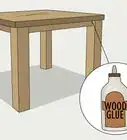This article was co-authored by Jeff Huynh. Jeff Huynh is the owner of Moseybolt, a full service solution in home services, renovations, and repair in the Greater Seattle area. He has over five years of handyman experience. He has a BS in Business Administration from the San Francisco State University and his Certificate in Industrial Electronics Technology from North Seattle College.
There are 8 references cited in this article, which can be found at the bottom of the page.
This article has been viewed 39,040 times.
If your furniture looks uneven or rattles when you touch it, it needs to be leveled. Fortunately, leveling is a simple task. Many pieces of furniture have adjustable legs you can use for an immediate fix. If your furniture isn’t adjustable, you can level it temporarily with shims or install adjustable feet for a long-term solution. Adjust your furniture to keep it pleasing and balanced.
Steps
Evening Adjustable Furniture
-
1Use a level to determine the furniture’s slope. You may be able to spot uneven furniture simply by looking at it. If you are unsure or need to figure out which side is higher, set a bubble level on top of your furniture. Wait for the fluid in the center to settle, since the bubble inside it will move towards the higher side.
- After adjusting the furniture, you can use the level to test it again. The bubble will stay in the center of the fluid once the furniture is even.
-
2Open the furniture and take out any drawers. Some pieces of furniture, including many armoires and entertainment cabinets, have slots you can use to level them by hand. Look for the slot holes inside the furniture, near the legs. They are often right inside the door or underneath the bottom drawer.[1]
- If your furniture doesn’t have holes, it may have adjustable legs. Check the legs to see if they are kept off the ground by small pads. These pads can be adjusted by hand.
Advertisement -
3Insert a leveler wrench into the side you want to adjust. Your furniture may come with a small tool which looks like an L-shaped pipe. First, choose the side you want to adjust. Then, put the socket end of the wrench in the hole on that side. Start with the lower side, bringing it to an appropriate height.[2]
- If you do not have a leveler wrench, use a flat head screwdriver instead. Push the head into the slot located in the hole.
- Most pieces of adjustable furniture have 2 holes so you can adjust both legs. If yours doesn’t, you may need to find alternative ways to finish the leveling process.
-
4Turn the wrench clockwise to lower the furniture. Gradually twist the leveler, stepping back on occasion to see if the furniture looks level. Work slowly to avoid raising the furniture too much. When the sides look even, you can put back any drawers or doors you removed earlier.[3]
- If you raise the furniture too much, twist the wrench counterclockwise to lower it back down again.
-
5Twist the adjustable feet by hand if your furniture has them. Look for small, rounded pads screwed into the bottom of your furniture’s feet. The screws allow you to level the furniture easily by lifting up the leg you wish to adjust. Turn the foot pad clockwise to raise the leg and counterclockwise to lower it.[4]
- Tables, desks, and dressers often have adjustable feet.
- If your furniture has legs that are flat on the ground, it doesn’t have adjustable feet. Check for leveler holes or use shims.
Leveling with Shims
-
1Place a level on top of the piece of furniture. Get a bubble level and center it on the furniture you wish to level. The fluid in the middle will have a bubble in it. The bubble moves towards the side that is higher, so you can quickly find out which way the furniture slopes.
- Have a friend hold the level in place if you can’t rest it on your piece of furniture. Alternatively, tape it in place.
- You can use other types of levels if you are familiar with them.
-
2Slide shims underneath the furniture’s base. Shims are small wedges used to level out all kinds of furniture. Position a shim at the back end of the side you want to raise. Lift the furniture up so you can fit the shim underneath it. If your shim is wedge-shaped, slide the thinner end in first.[5]
- Unlike feet, shims are not permanent and require no installation. This means that you need to readjust them every time you move the furniture, so reserve them for items you don’t move frequently.
- Shims are commonly made of wood, safe for use on walls or flooring. For carpeting or damp areas, switch to hard plastic to provide your furniture with more support.
EXPERT TIPJeff Huynh is the owner of Moseybolt, a full service solution in home services, renovations, and repair in the Greater Seattle area. He has over five years of handyman experience. He has a BS in Business Administration from the San Francisco State University and his Certificate in Industrial Electronics Technology from North Seattle College.Professional Handyman
 Jeff Huynh
Jeff Huynh
Professional HandymanYou could also sand the longer legs, rather than building up the shorter ones. Jeff Huynh of Handyman Rescue Team says: "Take the piece of furniture out onto a level surface, like a concrete slab, and determine which two legs have space underneath them. Then, use sandpaper to sand the other two legs down or adjust their angle."
-
3Push the shims in or stack them until the furniture is level . Check your level as you work. If the furniture isn’t level, you will need to give it more height. If you have wedge-shaped shims, push them further in so the thicker end is underneath the furniture. You can also set multiple shims on top of each other to raise the furniture further.[6]
- Be careful when lifting up heavy furniture. Work with a friend to make the process easier and safer.
- A stack of shims can be noticeable. There is no way around this, but it is better than wobbly, uneven furniture.
-
4Slice off excess material if the shim sticks out. Chances are the back end of any shims you use will stick out from underneath your furniture. This can be unsightly. To break a shim, use a sharp utility knife. Cut as close to your furniture as possible until you are able to pull the excess away.[7]
- Another way to break the shim is to slide a flat head screwdriver underneath it. Pry the shim up until it breaks, then twist off any remaining pieces by hand.
- You do not have to break the shims. If they aren’t noticeable, consider leaving them intact.
- This is usually reserved for wood shims. Plastic shims may be too difficult to break.
-
5Use alternative items to level furniture if you don’t have shims. You may have seen wobbly tables in TV shows fixed with a coaster or another random object. Any flat object can be used to level out furniture. Make use of items like cardboard or newspaper, slipping them underneath the furniture like you would with shims.
- This isn’t the prettiest solution, but it works in a pinch. Keep in mind that items like newspaper are more delicate than shims and leveling out your furniture with them can be more difficult.
Installing Adjustable Feet
-
1Measure the gap between the furniture’s short leg and the floor. Test the legs by shaking the furniture. Notice which leg rattles and stays off of the floor when you let go. Use a tape measure to record the gap.[8]
- The short leg needs extra support in order to level the furniture. Depending on what material you use, this measurement can make all the difference.
EXPERT TIP"Installing adjustable feet is great if you need to level a piece of furniture that's on uneven ground."
Jeff Huynh is the owner of Moseybolt, a full service solution in home services, renovations, and repair in the Greater Seattle area. He has over five years of handyman experience. He has a BS in Business Administration from the San Francisco State University and his Certificate in Industrial Electronics Technology from North Seattle College.
Jeff Huynh
Professional Handyman Jeff Huynh
Jeff Huynh
Professional Handyman -
2Wear safety goggles and a dust mask while drilling. You won’t need to do much drilling, but safety precautions are still important. Drilling into wood can release wood fragments and dust, so be sure to protect your eyes and airways.
- Also avoid wearing baggy clothing or jewelry, since these items can be caught by the drill. Tie your hair back if you need to.
-
3Drill pilot holes in the center of each leg. Clear out your piece of furniture and flip it over so you can access the legs. You will need to drill a hole through the underside of each leg. Use a drill bit 3⁄8 in (0.95 cm) in diameter to make the holes.[9]
- You do have to drill pilot holes if you want to install new feet. For antiques you don’t want to damage, consider leveling with shims instead.
-
4Thread brass inserts into the holes. You can make your own custom feet with a few components like brass inserts. Inserts are small, ridged rings used to hold the other foot components in place. Stick a brass insert into each hole, twisting them clockwise until they are all the way inside the feet. Use a screwdriver or wrench if you can’t get them in by hand.[10]
- You can also purchase premade furniture levelers. These items have steel T-nuts which take the place of the brass inserts but are installed the same way. They are about $15 USD for a pack of 8.[11]
- Another option is nail-on glides. You can push these into the drill holes without installing inserts. They are commonly used to protect flooring and cost about $2 for a pack of 4.[12]
-
5Screw an elevator bolt into the brass insert. Choose 2 in (5.1 cm) elevator bolts with wide, flat heads. The flat heads are necessary if you plan on attaching felt pads that prevent the bolts from scraping delicate flooring. Place a bolt in each brass insert, screwing them in clockwise until they are firmly in place.[13]
- Use the measurement you took earlier to level the legs. The screws are always adjustable, so you can let out the screw in the short leg to give it additional height.
- You can use hex-head machine bolts if you don’t need to protect the flooring, such as with outdoor furniture.
- If you are using nail-on glides, add washers to the glide on the short leg in order to extend it.
-
6Stick a felt pad to the bottom of each bolt. If the feet don’t already have felt pads on them, install your own pads so the screws cannot scratch your floors. Choose pads that are the same size as the bolt heads. Most pads are adhesive, so all you have to do is peel off the adhesive backing and press the felt pad to the bolt head.[14]
- You can usually find these pads at hardware stores along with the screws.
- You may also be able to cut your own felt, then glue it to the bolt using epoxy or another strong glue. This is also a way to replace felt pads as they wear out.
Warnings
- Take proper precautions when using power tools. Always wear protective gear and avoid baggy clothing.⧼thumbs_response⧽
- Lifting heavy furniture can be dangerous. Have someone help you to reduce the chances of injury.⧼thumbs_response⧽
Things You’ll Need
Evening Adjustable Furniture
- Leveling wrench or flat head screwdriver
Leveling with Shims
- Bubble level
- Wood or plastic shims
- Screwdriver
- Newspaper or other material
Installing Adjustable Feet
- Tape measure
- Protective goggles
- Dust mask
- Brass inserts
- Elevator bolts
- Felt pads
References
- ↑ https://www.jordans.com/~/media/files/pdf/customer-relations/jordans-leveling-booklet.ashx
- ↑ https://www.jordans.com/~/media/files/pdf/customer-relations/jordans-leveling-booklet.ashx
- ↑ https://www.jordans.com/~/media/files/pdf/customer-relations/jordans-leveling-booklet.ashx
- ↑ https://www.jordans.com/~/media/files/pdf/customer-relations/jordans-leveling-booklet.ashx
- ↑ https://www.youtube.com/watch?v=TyTOSixsJv4&feature=youtu.be&t=13
- ↑ https://www.jordans.com/~/media/files/pdf/customer-relations/jordans-leveling-booklet.ashx
- ↑ https://www.youtube.com/watch?v=TyTOSixsJv4&feature=youtu.be&t=21
- ↑ https://www.popularmechanics.com/home/interior-projects/how-to/g2538/furniture-problems-you-can-fix/
- ↑ https://www.youtube.com/watch?v=nerH2ht97Xo&feature=youtu.be&t=128
- ↑ https://youtu.be/tIhEqoKE8Dc?t=91
- ↑ https://www.architecturaldigest.com/story/adjustable-feet-15-dollar-fix-for-uneven-floors
- ↑ https://www.popularmechanics.com/home/interior-projects/how-to/g2538/furniture-problems-you-can-fix/
- ↑ https://www.architecturaldigest.com/story/adjustable-feet-15-dollar-fix-for-uneven-floors
- ↑ https://www.architecturaldigest.com/story/adjustable-feet-15-dollar-fix-for-uneven-floors










































































